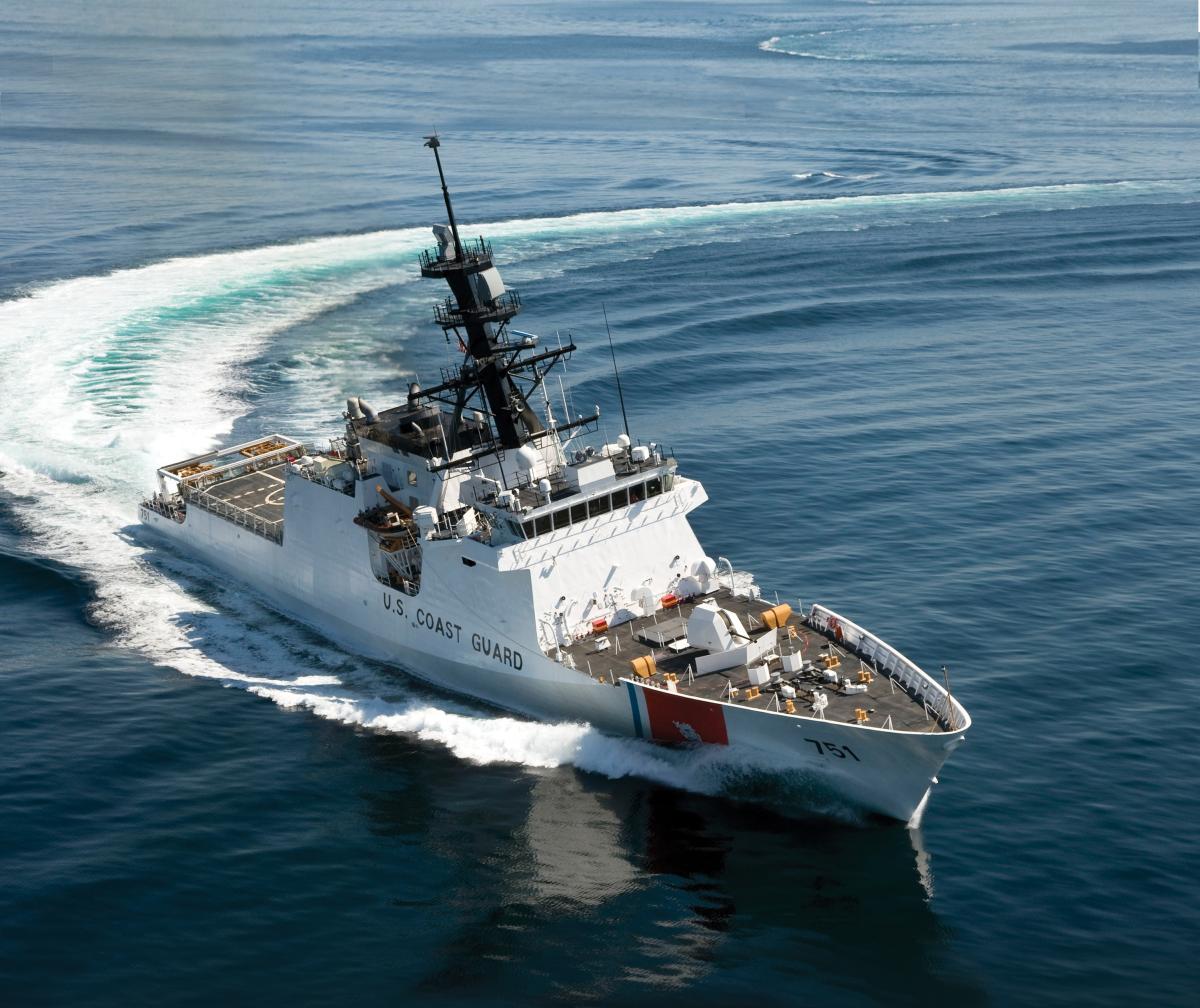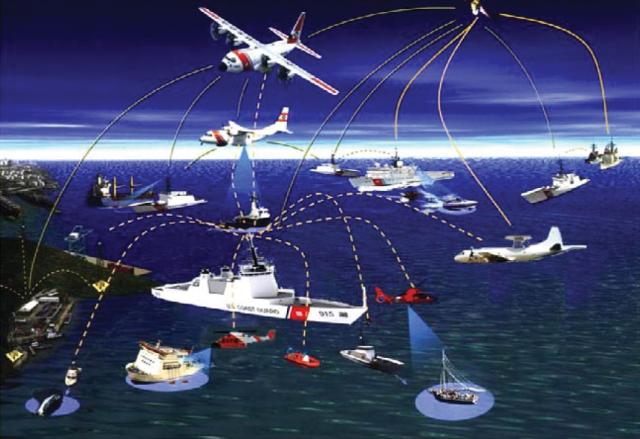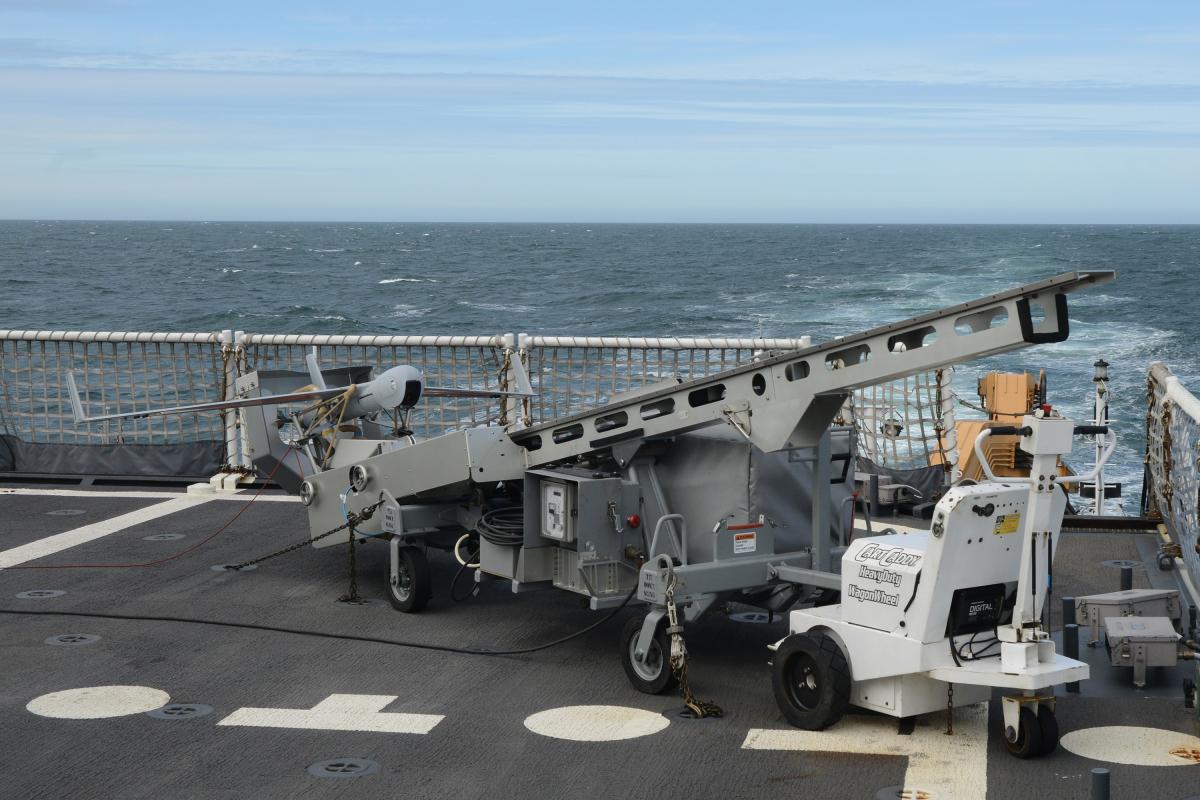For generations, endurance has been the Coast Guard’s primary metric for classifying its white-hull cutter fleet. Patrol boats are nimble near-shore workhorses, medium-endurance cutters can deploy longer and embark a helicopter, and high-endurance cutters have a global range and resemble Navy frigates. Yet, as the new fleet of fast response cutters (FRCs), offshore patrol cutters (OPCs), and national security cutters (NSCs) comes online, connectivity—the ability to send and receive information and integrate with other platforms—is growing increasingly more relevant as a measure of capability.
Fast, reliable, and secure connectivity is the key to implementing new operating concepts that can vastly enhance mission effectiveness. Regrettably, the current state on even the most advanced cutters ranges from marginal to abysmal. Unless the Coast Guard prioritizes improving underway connectivity, the future cutter fleet will not realize anything near its full potential.
The Vision–Reality Gap
A once-popular concept graphic hearkening back to the “network-centric” era shows Coast Guard cutters, boats, aircraft, unmanned systems, and command centers all coordinating efforts and sharing information via a combined satellite and terrestrial command-and-control (C2) network. Curiously, the NSC serving as the C2 hub appears to be just offshore, while most of the action takes place farther out to sea. One sailor, a technician charged with maintaining NSC network systems, liked to joke that the NSC was staying near shore because the internet cable required to maintain that level of C2 functionality did not stretch any farther.
This witty barb reveals a painful truth. Underway connectivity is the cutter fleet’s Achilles heel. The NSC and FRC are phenomenally capable platforms, with major upgrades over their legacy predecessors in electronics, sensors, habitability, seakeeping, and efficiency. Yet despite their advanced C4ISR suites, once under way they often struggle to perform basic connectivity-based functions, such as accessing Coast Guard websites for routine administrative tasks, never mind serving as powerful C2 nodes in a networked system. The situation is analogous to pairing new high-end laptops with spotty dial-up internet.
Having sailed on both an FRC and NSC, I offer a few vignettes contrasting oft-heard statements of the Coast Guard’s vision of new cutters’ capabilities with an operator’s perspective on the challenges to achieving that vision.
Vision: Shipboard IT systems enable real-time information sharing.
Reality: The cutter fleet struggles to meet the information receipt and transmission demands required for efficient operational decision-making and intelligence processing. This is especially true with imagery.
Cutters lack the ability to transmit digital imagery directly from their integrated shipboard camera systems, so common practice is to take digital pictures and send them by email. Coast Guard network security policy prohibits connecting digital cameras or any flash media to Coast Guard workstations, so the images must be downloaded from a camera on to a personal computer, burned on to a CD, transmitted from the CD to a workstation, then reduced in size to meet email attachment constraints. The process is laborious under ideal circumstances and can be near impossible when connectivity is poor.
Oftentimes while patrolling coastal waters on the FRC, it was faster to avoid the shipboard systems entirely and instead take pictures with a smartphone, drive close enough to shore to pick up a cellular signal, and send photos from the phone. Unfortunately, there is no equivalent workaround when operating farther offshore.
Vision: New cutters will have interoperable systems providing a common operating picture (COP).
Reality: A COP shared among Coast Guard and Department of Defense units and interagency partners remains an enticing but elusive goal. Even when reliable connections exist, system incompatibility often inhibits data sharing.
Case in point: while on an FRC serving as the on-scene coordinator for a multiasset search-and-rescue (SAR) mission to locate a missing diver, our shore-based command center generated search patterns for the 18 assets involved using a SAR plotting program. However, it could not interface with our SeaWatch COP system to transmit the patterns directly to us, so it had to pass dozens of waypoint coordinates via radio, which we in turn plotted, manually inputted, and relayed to other units. While executing the mission, we had no data link to feed position information from the other interagency assets involved into our COP, so we tracked them via hourly position reports by radio. Overall, there was little difference in how we, on a newly commissioned FRC, executed the mission compared to a legacy patrol boat.
Vision: NSCs serve as capital ships and C2 platforms for the fleet.
Reality: NSCs have excellent sensors and integrated tactical data displays, but they often are hamstrung in sending and receiving information outside the cutter.
During a recent counterdrug patrol in the eastern Pacific on an NSC, we spent most of the deployment outside the coverage area provided by our commercial Ku-band satellite-based underway connectivity system. We connected instead to Fleet Broadband (a Navy system with greater coverage but less bandwidth), which proved inadequate for maintaining the network throughput capability to operate our classified and unclassified systems. For most of the patrol, we could not download daily intelligence briefs or reliably maintain a secure data chat function with our tactical control and other units.
On the unclassified side, message traffic, weather, and Coast Guard web-based applications would not load, which put our logistics and administrative processes in turmoil. Joint Interagency Task Force–South tasked us to assist an FRC in the area by providing intelligence targeting information, but we could not establish a reliable enough data link to do so. Nor could we send out much of the visual imagery from our law enforcement cases required for legal and intelligence processing until we returned to Ku-band coverage several weeks later.
Put bluntly, in the past several years cutter connectivity has climbed in urgency from concern to crisis. The negative impact of poor connectivity on current mission execution already is cause for alarm, but the more important concern is the constraint it will place on the Coast Guard’s ability to shape future operations.
Network > Platforms
The Navy’s distributed lethality concept highlights the ever more pivotal role connectivity will play in future operations. Lethality is not the Coast Guard’s main priority, but the underlying idea of sharing sensors and capabilities among platforms is a paradigm shift that could increase Coast Guard mission effectiveness by an order of magnitude. As Chief of Naval Operations Admiral John Richardson observed, “When you start linking platforms together, the rate of progress is not exponential, it’s factorial.”1
Within the distributed lethality network, any platform can access data collected by the other platforms to track and even target adversaries that are beyond the range of its own sensors (“if it floats, it fights”). As a result, the importance of organic capabilities on individual platforms diminishes relative to the overall capability of the networked whole. One group tasked to study Navy fleet design concluded that the network, not any physical vessel, will be the true “capital ship” of the future.2 Naturally, passing target data and sensor feeds among platforms requires sending and receiving massive data streams, so connectivity is a key enabler to bringing the concept to fruition.
Adapted for Coast Guard mission requirements, distributed lethality might be better termed “distributed specialized capabilities,” but a similar sharing of resources and data among platforms would yield considerable advantages. For one, a networked fleet casts a far more effective maritime domain awareness net than is currently achievable. If an NSC could transmit its integrated air, surface, and emission detection picture to other platforms, the overall value of those capabilities would compound significantly. Adding visual and signals data acquired from emerging systems such as the ScanEagle small unmanned aerial system (sUAS) and longer-range UASs still under development would provide the fleet with far more aerial intelligence, surveillance, and reconnaissance (ISR) than embarked helicopters and maritime patrol aircraft sorties can generate. Combining the systems into a commonly accessible tactical display would enable a patrol boat, operating alone and unafraid with just a surface-search radar and a lookout, to gain a level of situational awareness on par with a command center.
The concept grows even more compelling when one considers the potential of integrating more sophisticated capabilities available for cutters to “pull down” on demand. As unmanned technology matures, the Coast Guard could expand its mission scope beyond ISR by configuring platforms with tailored mission packages for law enforcement, search and rescue, surveillance, or homeland defense. A SAR drone, for example, might launch to execute a search pattern, send imagery to the cutter acting as the on-scene coordinator upon detecting a contact that fits the description of an imperiled vessel, then mark the position with flares and deploy survival and assistance equipment while a cutter is en route. Each SAR-configured platform added to the network would increase the probability of detection and reduce the time to get assistance on scene, resulting in lives saved.
The Coast Guard is just beginning to scratch the surface with unmanned systems, but no one can doubt the significance of their emerging role in both military and private industry applications. The possibilities are vast, the window for innovation is wide open, but the connectivity status quo remains a critical inhibitor.
Confronting the Conundrum
The first step toward bringing the cutter fleet out of the connectivity doldrums is upgrading the urgency to make it a service imperative. The Coast Guard C5I community has delivered many outstanding operational capabilities to date, but poor underway connectivity persists despite a steady chorus of lamentations from the fleet. Admiral Kevin Lunday, former head of Coast Guard Cyber Command, argued that the Coast Guard needs to view cyber capabilities as a mission platform.3 That perspective is dead on. Poor connectivity degrades cutter mission execution as much as, and in some respects more than, having a non-mission-capable helicopter or cutter.
A welcome near-term mitigation measure would be optimizing cutter systems and software to reduce the bandwidth drain required to perform routine tasks. Unfortunately, the trend to date has moved in the opposite direction. The enterprise-wide migration to Windows 10 and steady increase in required multigigabyte software patches bog down already struggling underway data pipelines to the point of failure. Cutters must run the same software image designed for shore units linked to high-speed landlines, including cloud-based programs that demand huge amounts of data transfer to use. Providing cutters with stripped down “lite” versions of commonly used applications for finance, admin, and operational functions would help immensely. In addition, having the ability to separate secret (SIPR) and unclassified (NIPR)data pipelines would eliminate the need to shut down the unclassified server to husband enough bandwidth to keep the tactical data link functioning.
Cutters also need better organic technical support to maintain IT and electronics systems while deployed. Currently, the fleet leans heavily on contracted technicians to maintain many of its computer and electronics systems. For some systems, a single person travels from cutter to cutter for troubleshooting and repair requests. That model is far too fragile for cutters that deploy for several months, sometimes out of the hemisphere. Meanwhile, shipboard technicians often do not get the depth of training required to diagnose and repair nonroutine problems, and in some cases lack the required permissions to access higher-level maintenance functions. Attempting to use the Coast Guard’s centralized IT service desk for assistance creates a chicken-or-egg dilemma, since getting remote assistance requires first establishing a data connection.
The longer term and costlier solution requires investing in larger and more diversified data throughput options. In that endeavor, the Coast Guard should seek to leverage the Navy’s considerable investment and ongoing efforts toward the same end. Whereas the Coast Guard has only one satellite channel available to run both SIPR and NIPR nets, the Navy uses several, across multiple frequency ranges, and at much higher transmission rates. It also tiers bandwidth allocation according to C2 requirements. Dedicated C2 platforms, such as flagships with an embarked command staff, get proportionally more bandwidth assigned. (By contrast, a Coast Guard NSC, even when serving as a task force commander during a contingency response operation, has about the same available bandwidth as a patrol boat.) Those measures enable a wealth of valuable features, such as underway secure video teleconferencing, the ability to send and receive live imagery, and the option to redirect data streams to alternate channels when one gets overburdened.
Coast Guard research, development, and acquisition resources clearly are more limited than the Department of Defense (DoD) services, but the return on connectivity improvement is well worth the investment. The OPC currently is the Coast Guard’s top acquisition priority, and compared with the legacy medium-endurance cutters it will replace, it outclasses them in nearly every respect. If the current connectivity situation persists when the first OPC is delivered, however, it will be constrained from the moment it is commissioned by many of the same operational limitations as its forebears.
Ensuring Maximum Utility
In a 2018 prize-winning Proceedings essay, Commander Daniel Wiltshire argued that the Navy should distribute lethality to Coast Guard cutters, meaning include them in the battle network.4 Much of the essay focused on ways to upgrade the weapon systems on certain cutter classes to make them more effective in surface engagements. The idea has merit; the Coast Guard needs to redefine its role within the Navy’s future fleet design to maintain relevance in its defense readiness mission area. However, the most important factor for distributing lethality (or any operational capability) to the cutter fleet has less to do with armament than it does with bandwidth and software and sensor integration. The real value Coast Guard cutters could provide to a DoD battle network is serving as maritime sensor nodes that can relay targeting data to the shooters. As the situation currently stands, many underway cutters would have difficulty looking up “long-range antiship missile” on a website search engine, let alone providing a DDG or F-35 with a targeting solution for one.
The Coast Guard is a small service with a huge mission scope; it needs to be the most innovative and efficient with the resources it has. It fought hard for years to get the acquisition funding to recapitalize the legacy fleet. Now it needs to ensure it employs its superb new cutters to their maximum utility. Size, speed, sensors, range— all of the traditional metrics of cutter performance are still important. However, to accurately gauge a cutter’s present and especially future operational potential, there are three additional factors that must be considered: Who can they connect with? Where can they connect from? And how fast is the connection?
1. Megan Eckstein, “CNO Richardson Envisions Network of Sensors, Payloads for Fleet Commanders to Access as a Service,” USNI News, 21 July 2017.
2. CAPT Robert C. Rubel, USN (Ret.), “Think Outside the Hull,” U.S. Naval Institute Proceedings 142, no. 6 (June 2017).
3. David Thorton, “Coast Guard Cyber Command Just As Important As Cutters or Aircraft,” Federal News Radio Network, 14 December 2017.
4. LCDR Daniel Wiltshire, USCG, “Distribute Lethality to the Cutters,” U.S. Naval Institute Proceedings 143, no. 9 (September 2018).






